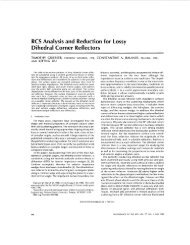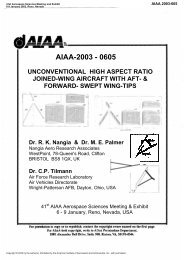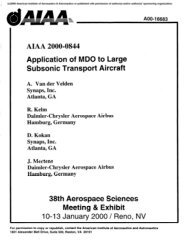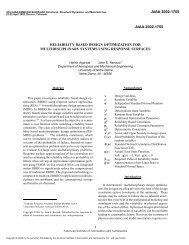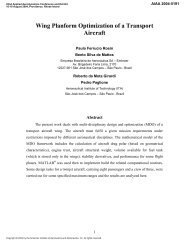The design report
The design report
The design report
Create successful ePaper yourself
Turn your PDF publications into a flip-book with our unique Google optimized e-Paper software.
It was here that the first problem was identified. <strong>The</strong> left engine would sometimes fail to<br />
power on, resulting in the left propeller spinning slowly or not at all, while the right<br />
worked perfectly. Although investigations were made into the causes of this<br />
phenomenon, it was concluded that the problem lay with the motor itself, rather than<br />
with any error made by the fabrication team, and hence the team was unable to find a<br />
permanent solution. <strong>The</strong> solution embarked upon was simply to switch the engine on<br />
and off until both engines began working to their full extent. It was estimated that the<br />
engine failure would occur approximately 50% of the time. This approach worked well,<br />
although it did raise some concerns that the engine might fail mid flight, which would<br />
have had a disastrous result. However, the team did not deem this to be too imminent a<br />
threat, as in all of the tests the engine only ever failed at the initial power on, never once<br />
it was already running.<br />
After it was satisfied that the engines and control surfaces were working effectively, the<br />
engines were powered up to the point where the aircraft began to move. After this<br />
began a series of ground exercises, <strong>design</strong>ed to test the maneuverability of the EPUAV.<br />
<strong>The</strong> first task undertaken was to simply taxi in a straight line.<br />
Here the second problem was encountered. When no controls were pressed other than<br />
the throttle, the vehicle should ideally have moved in a straight line. However, it was<br />
discovered that iSpy instead was turning slightly right. This was initially immensely<br />
dangerous to iSpy, as all the team members were relatively new to the use of the<br />
controls, and would try to compensate for the movement right with a large and sudden<br />
movement left, which on several occasions put the plane in peril, as it veered towards<br />
obstacles such as bikes. <strong>The</strong> cause of the crafts tendency to veer right was investigated,<br />
as was determined to be the fault of the right landing gear.<br />
<strong>The</strong>re were several reasons for which the right landing gear was malfunctioning. <strong>The</strong><br />
first of which was that during the manufacturing process the steel rod from which the<br />
landing gear was created was bent into shape by hand. This meant that a perfect right<br />
angle turn could not be achieved, and therefore the angle between the horizontal where<br />
the wheel was attached and the vertical component connecting to the fuselage was<br />
slightly greater than the desired 90 degrees. This was more a problem for the front<br />
landing gear, as the steel rods from which they were constructed were provided by the<br />
university, and were more difficult to bend than those used in the rear landing gear,<br />
which were purchased by the team. As a solution to this problem, it was suggested that<br />
the landing gear could be taken to a metalworkers, however, the problem was initially<br />
not deemed of great importance, and this was never followed up on.








![Introduction to RF Stealth [Book Review] - Antennas and ...](https://img.yumpu.com/16857890/1/190x245/introduction-to-rf-stealth-book-review-antennas-and-.jpg?quality=85)

